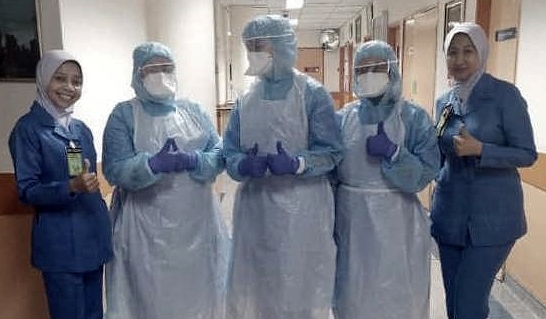By Prof Dr Victor Hoe Chee Wai / Associate Prof Dr Marzuki Isahak / Associate Prof Dr Nirmala Bhoo Pathy / Associate Prof Dr Rafdzah Ahmad Zaki / Associate Prof Dr Mas Ayu Said
Healthcare workers at all levels have been tirelessly working in the time of this COVID-19 pandemic. This has inevitably placed them, especially the front-liners at high risk of being infected. In Malaysia, we have indeed been seeing the growing pressure that the COVID-19 outbreak had exerted on our healthcare workers, through social media and news reports. Despite the risk, our unsung heroes in healthcare put aside the fear of getting infected themselves or worse still, infecting their vulnerable family members, and continue their duties in their respective hospitals and clinics.
While we all know that it is paramount that our healthcare workers are protected, many may be wondering who works behind the scene in protecting our healthcare workforce including our doctors, paramedics, nurses, attendants, ambulance drivers, hospital cleaners, etc. in a pandemic. In the University Malaya Medical Center (UMMC), the non–Ministry of Health facility managing patients with COVID-19, the Occupational Safety, Health and Environment (OSHE) Unit and the Public Health Department has been working tirelessly to ensure the safety and health of its workers. Both the OSHE Unit and the Public Health Department or Jabatan Kesihatan Awam (JKA) in UMMC were established more than a decade ago with an overarching aim of ensuring the health, and safety of all healthcare workers, and visitors of the hospital.
During a large-scale threat from an infectious disease such as from COVID-19, the occupational and public health experts from these organizational units are tasked to come up with guidelines for the healthcare organization. Importantly, algorithms are developed to assess the risk of an individual healthcare worker who has been exposed to a confirmed COVID-19 patient in the facility. This is a very critical step for informing infection prevention and control recommendations. Although the algorithms developed by such teams may vary from one organization to another, the central theme remains the same, which is to help to classify the exposed healthcare workers into high risk, medium risk, or low risk groups. Now, why is this important?
A healthcare worker who is deemed to be at high risk of being infected will need to undergo testing for SARS–CoV-2 virus infection and be put on quarantine for up to two weeks in a designated place. Apart from protecting the affected staff, this also prevents the potential spread of the disease to their family members, co-workers and other patients. On the other hand, a healthcare staff who is deemed as having low risk of infection may need to be monitored for fever and respiratory symptoms daily, for up to two weeks. Healthcare workers who are at low risk of being infected may be allowed to go back to perform their duties if they are asymptomatic, and proper control measures were in place during their encounter with a patient with COVID-19. Proper control measures include engineering measures (e.g. negative pressure room), and use of personal protective equipment (e.g. face mask, shield). Notably, identification of healthcare staff at low risk of infection is equally important as it avoids the collapse of clinical services due to lack of staffing, therefore allowing the healthcare facility to continue operating at an optimal level to serve Malaysians in need of medical care.
As the number of COVID-19 cases is increasing in the country, the number of exposed healthcare workers will also be increasing. Therefore, occupational safety, health and environment units, and public health departments play key roles in assisting healthcare organizations to protect their workers, which in turn ensures business continuity when pandemics like COVID-19 threatens to disrupt clinical service provision. On a last note, it is also equally important to be aware that the safety of our healthcare workers ultimately lies in the hands of Malaysian citizens who have the responsibility to be honest and declare their risks when visiting healthcare facilities during this difficult time.
[Prof Dr Victor Hoe Chee Wai (Occupational Health Physician); Associate Prof Dr Marzuki Isahak (Occupational Health Physician); Associate Prof Dr Nirmala Bhoo Pathy (Epidemiologist); Associate Prof Dr Rafdzah Ahmad Zaki (Epidemiologist); Associate Prof Dr Mas Ayu Said (Epidemiologist), Occupational Safety, Health and Environment Unit/ Department of Public Health, University Malaya Medical Center AND Department of Social and Preventive Medicine, Faculty of Medicine, Universiti Malaya.]

ADVERTISEMENT
ADVERTISEMENT


































